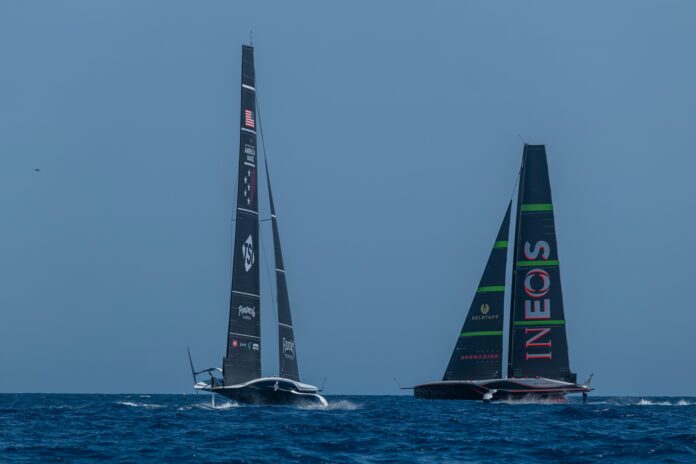The drysuits may still be on but summer is fast arriving in Barcelona and on Monday it was NYYC American Magic and INEOS Britannia that kicked off their week of training with some entertaining sailing in a breeze that built to around 15 knots and then faded through the afternoon atop a sharp easterly wind-chop. Another day, and another clue as to the possible direction of the Louis Vuitton Cup but one thing is for sure, the British have a package that is set to take on the world.
Having docked out at 11am, INEOS Britannia was first to the racecourse area just off the Barceloneta beachfront and initially went in for some fast training with the team pushing the platform harder and harder. Sir Ben Ainslie and Giles Scott looked immense sailing together, transitioning well and nailing the manoeuvres both upwind and downwind. A possible collision with a piece of floating debris made the session feel dis-jointed but safety first, the team spent some 90 minutes checking that all was okay with Britannia before resuming sailing.
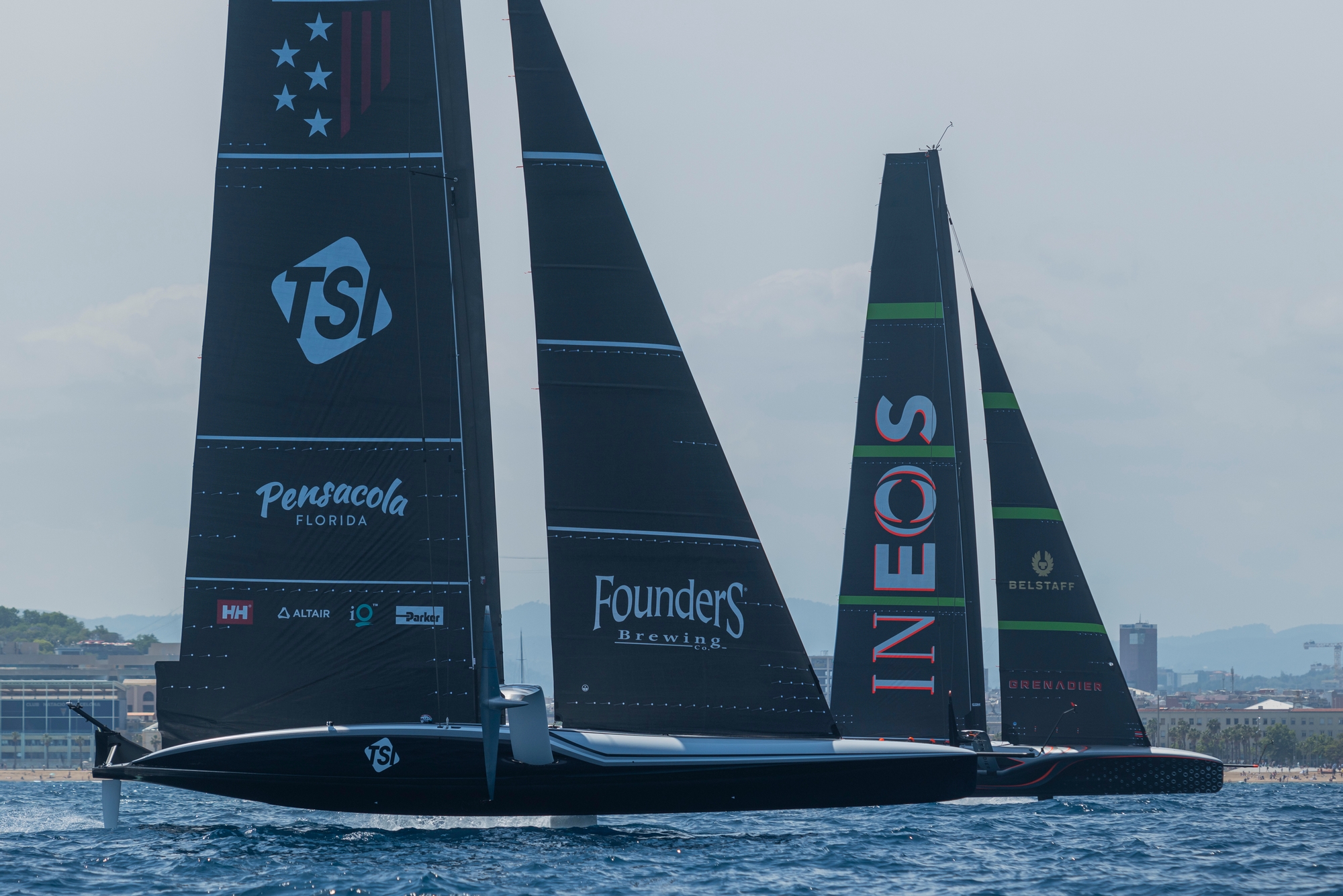
The take-away that will everyone sitting up was an unofficial line-up in the same stretch of water as NYYC American Magic and in a straight-line, INEOS Britannia appeared to very much have the edge. Many people’s tips to both make it to the Louis Vuitton Cup Final that starts on the 26th September, these two engaged for a short while before shearing away and continuing sailing.

Sir Ben Ainslie spoke to the recon team after sailing and summed up the day saying: “It was a long day for us, it wasn’t our most efficient day that’s for sure, we had a couple of issues there which stopped the boat for a while but good range of conditions and certainly some good learnings across that range that we’ll take away…We had an issue with the rudder, we weren’t sure if we hit something or not and we were maybe being a little bit cautious but we really wanted to make sure that it wasn’t something serious that when we started sailing again we might lose the rudder or worse so yeah that was what really what held us up there which is a bit frustrating, but it happens.”

The rudder area is a key focus for the team as Ben explained: “It’s really interesting changing the immersion if you like or the length of the rudder and it does make a bit of difference to the set-up of the boat as you’d expect and the performance as well, and it’s trying to find that balance particularly there was a little bit of chop sea-state around so trying to figure out just how hard we can push that without losing the rudder out of the water – we really don’t want that to happen.”

Ben is clearly eyeing the next few months as critical to the campaign with the team working through both technique and systems upgrades, saying: “That’s just ongoing, I think all of the teams will be playing with that all the way through up to and including the competition and I’m sure for us and I’m sure it’s the same for the other teams there’s so much more potential to come out of these boats and that’s really the trick for all of us over these next 2-3-4 months is just how much can we fine tune the boats to get more consistency and of course improve that performance both straight-line and manoeuvres.”
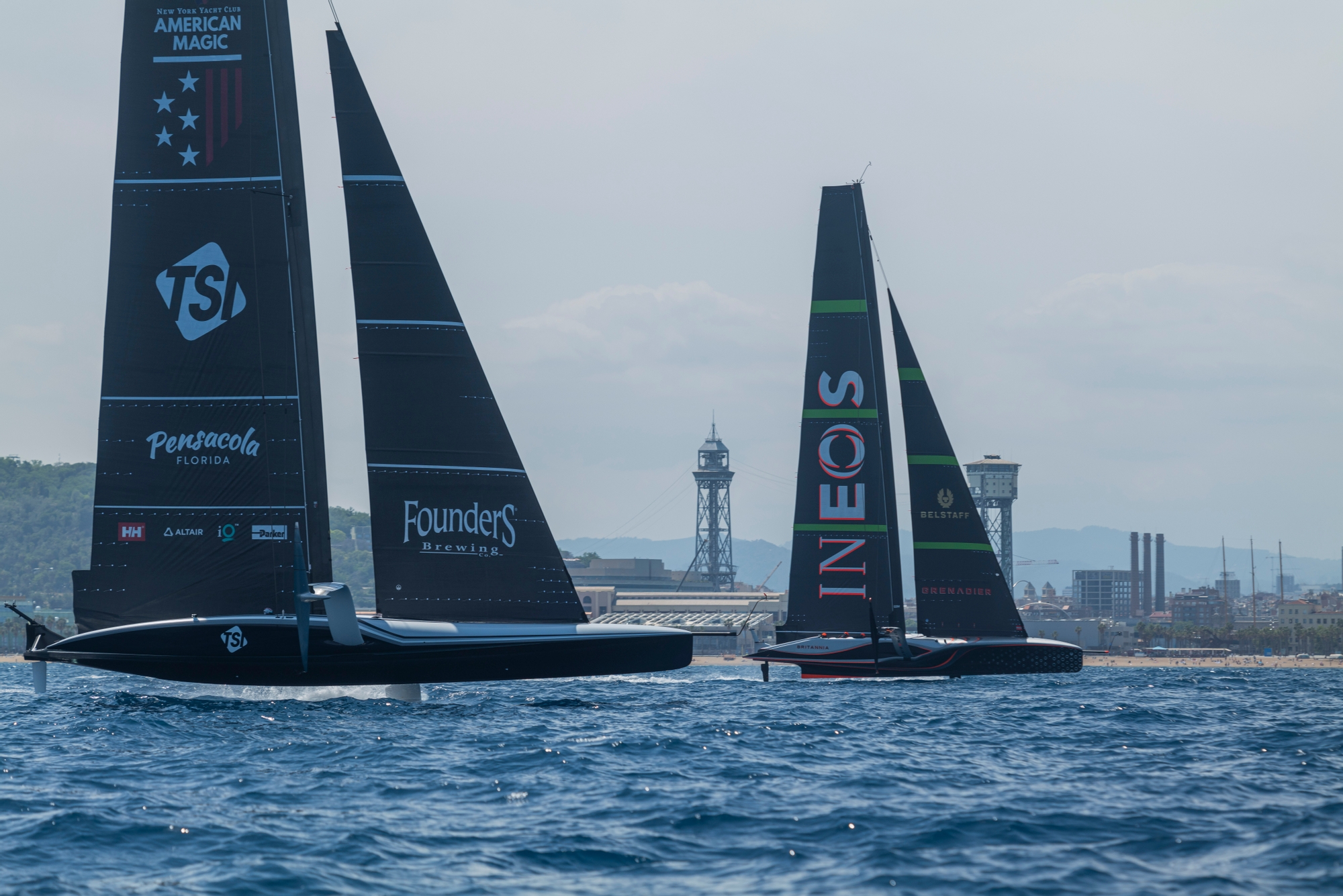
When asked about reports in the New Zealand media that Emirates Team New Zealand had computer modelled all of the current designs in this Louis Vuitton 37th America’s Cup cycle and felt comfortable with what they saw, Ben added: “I hope it’s wrong, but we all hope that’s wrong. Sure we all know that the Kiwi models are very sophisticated so it may be correct, we do something similar within our own team obviously we have a slightly different opinion on that, but it’s one of those things that each team’s models are really exclusive to themselves and that’s really critical as we know, not only in the design of the boat and the components but also the development of them and like I said earlier that refinement is going to be absolutely critical over the next three 4-5 months. We all know the Kiwis are going to be super-fast, they’re the team to beat, and the rest of us are laser-focused on trying to get there.”

For NYYC American Magic it was a solid day on the water going through jib cross-overs and technique as helmsman Paul Goodison described: “It was just straight into a bit of race-training, we had a couple of things to try technique wise on some of the manoeuvres but mainly it was just about going around the racecourse and getting a bit used to that. The forecast looked really good this morning look like it was slowly ramp and ramp and get windier and windier and I think we met the peak breezes when we got out there like 14-15 knots and then then it slowly dropped and dropped and dropped so we had a good look at the J2/J3 crossover and also at the end in some of the lighter conditions with the J2, so it was quite a good day.”

The American team have been relentlessly playing with rails on their foils and Paul explained more, saying: “I think it’s just about reducing the drag of the spray on the foil. And the reason we have so many that we’ve changed around is just to get a better feel for which ones we’re using more, which ones we use upwind, which ones we use downwind. You see today like the sea state was quite big compared to previous days, so you just get a feel how much they’re going in and out of the water and really just seeing which ones you think are working the best…I think you’d be lying if you could feel the difference, but I think it’s more visual, just seeing what’s going off and again looking at the cameras afterwards seeing where you’re spending most of the time on the foil.”

And talking about the new rudder, Paul seemed more than happy with the latest iteration, saying: “The new rudder is a good step on from the previous generation, so it’s definitely easier to drive the boat on, to push the boat a bit harder and I think it’s a good step forward so we’re really, really, pleased with the new rudder.”
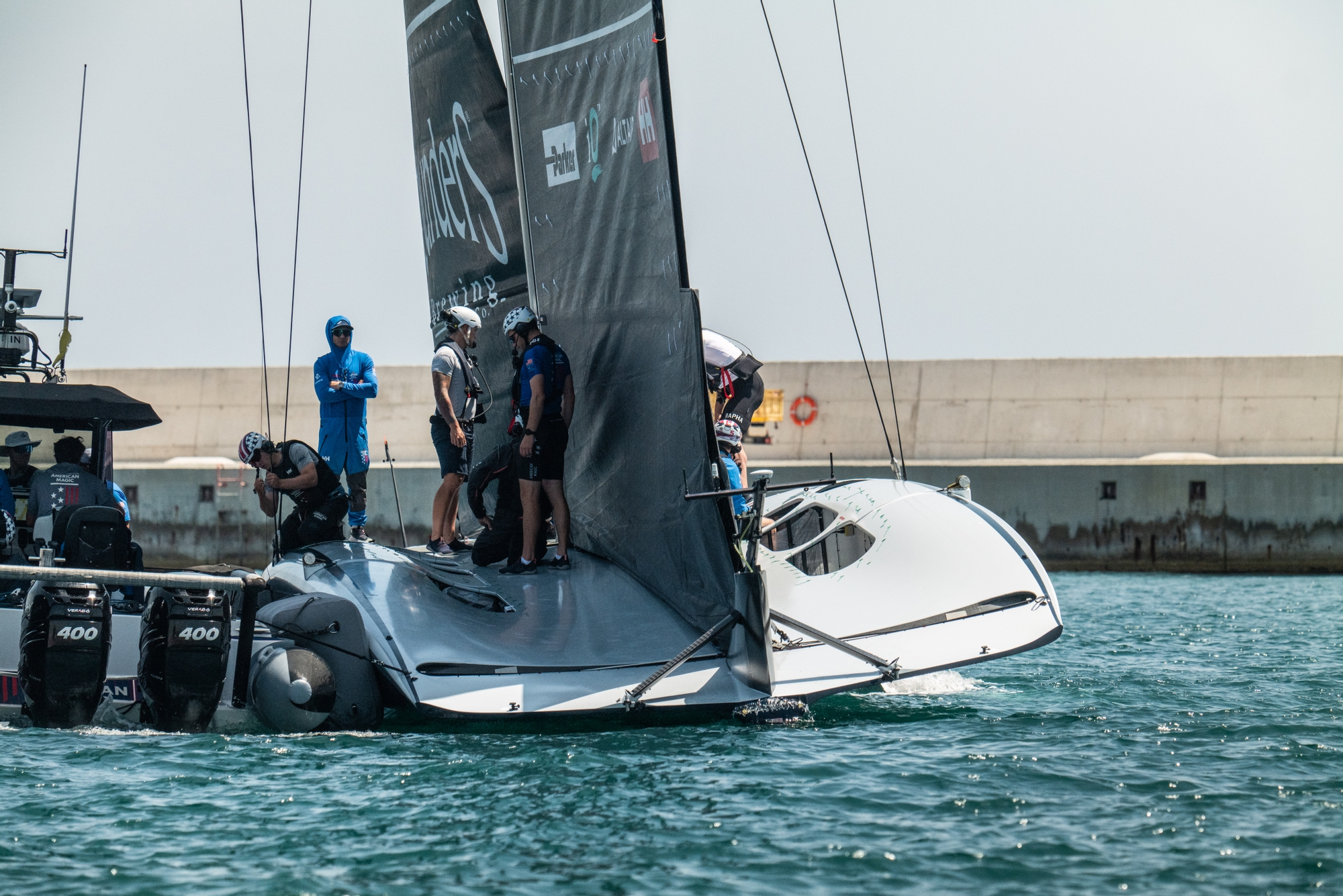
Down in wintery Auckland, it was another day for Emirates Team New Zealand operating at a very high pace with gusts of up to 18 knots at times making their two-boat AC40 session, a real screamer. The big focus was on pre-starts and crucially the final lead back into the line that was almost breath-taking to watch at the speeds they were doing. Both teams were on point today, giving very little away and the positional placement of the boats into the final run were executed with real intensity and usually dictated the outcome.
On-Water Recon Report – INEOS Britannia: INEOS Britannia rolled out their AC75 at 08:00 today and we could see the onshore operation team working with plumb lines, measuring tapes and total stations before stepping the mast. Crane in was at 09:30.
Same cameras as last sailing session were installed on both port and starboard foils. LiDAR cameras for the mainsail and jib were also on board. We could see also that a spray protection had been installed for the trimmers pods.
Dock out was at 11:00, when Britannia was towed to the entrance of the harbour where sails were hoisted. Mainsail MN2 was paired to a J2 jib. A wind of about 6-8 knots TWD 90 º @11:25 was blowing when they finished hoisting the sails and rapidly increased to 10-14 knots after sailing 1 mile out from the harbour. After 30 minutes sailing, 4 tacks and some straight lines were done and just after they bore away and touched something with the rudder. They had to stop and check that the rudder was fine so they could keep the sailing session running. This took around 90 minutes. Meanwhile they changed the jib to the J3 as the wind had increased.

Once they managed to verify that the boat was fine, they continued the training session which basically can be summarized in 9 upwinds and 9 downwinds where 32 tacks and 24 gybes were drilled. 4 of them (up & downwinds) were done as 2 x 2 lap races (10 minutes each lap) including a pre-start process at each of them. Mark rounding’s were practiced at almost every single upwind and downwind (sometimes with virtual marks, sometimes with physical marks) alternating the side of the roundings to starboard and to port each time.
One swap of batteries was done at 15:25, almost 4 hours after they started to sail (almost 2 hours of effective sailing). Two cyclor swaps were done: the first after 45 minutes of effective foiling, the second after 80 minutes of effective foiling. Three jib swaps were done: from J2 to J3 (wind increased from 6-8 to 10-14 knots); from J3 to J2 (wind decreased from 10-14 to 6-8 knots); from J2 to J3 (wind increased from 6-8 to 9-12 knots).
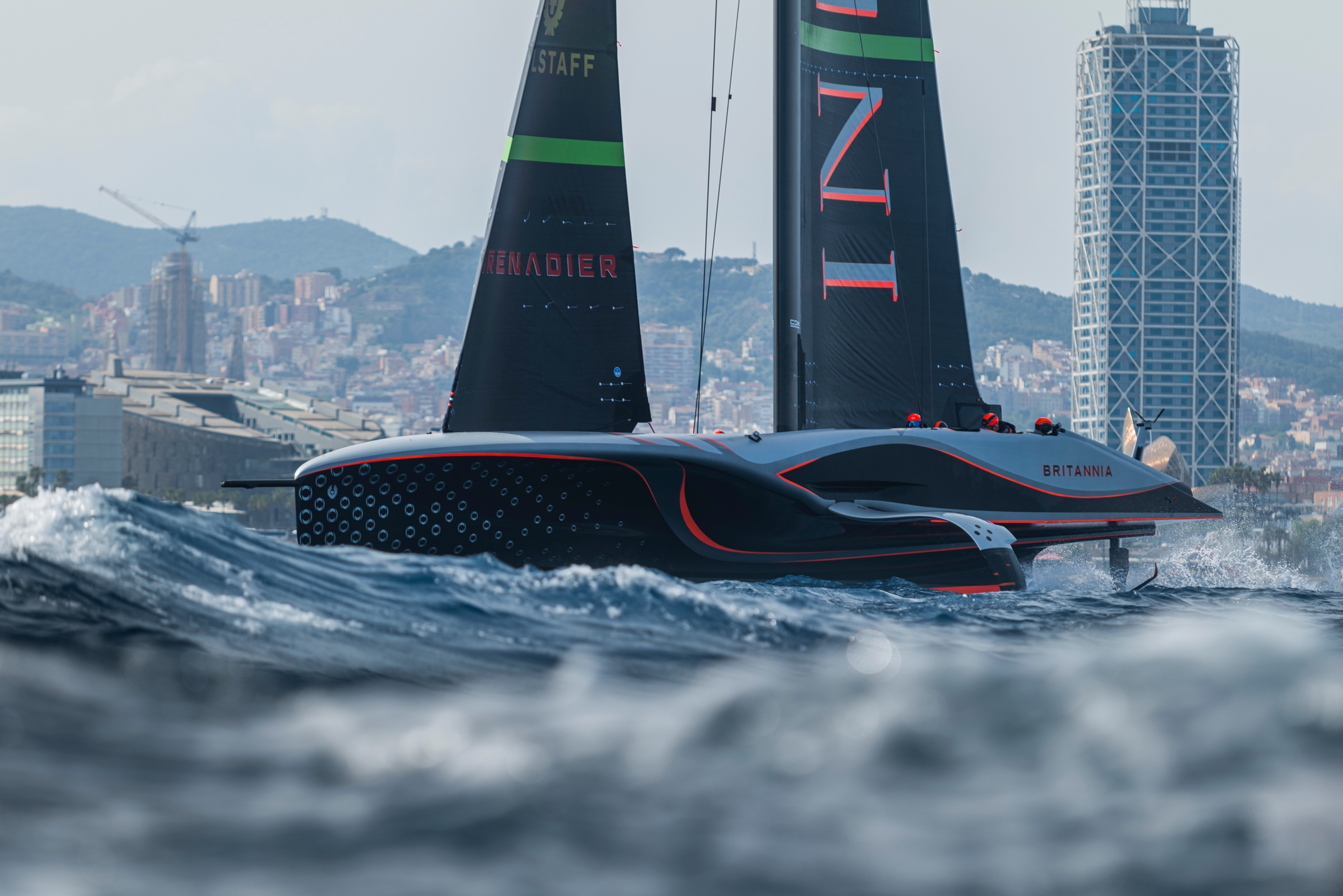
To highlight the following events:
-In one of the upwinds, very interesting crossings were seen with American Magic team.
-A hard nosedive was seen in a gybe manoeuvre at the first gybe from the second lap of the first practice race where they lost the Windex from the bowsprit.
-After the last cyclor swap, Britannia started sailing upwind and we couldn’t see properly what happened but suddenly we saw the bow going quite high. Not sure if the rudder was close to go out from the water surface and what we saw was the reaction from a safety system to avoid that. Immediately Britannia stopped, they changed the jib from J2 to J3 and some technicians jumped from the chase boat to perform some quick checks.
Team INEOS Britannia dropped the sails at 17:30 h and docked in at 17:50 h after approximately 190 minutes of sailing. Jose Luis Piñana – INEOS Britannia AC Recon




